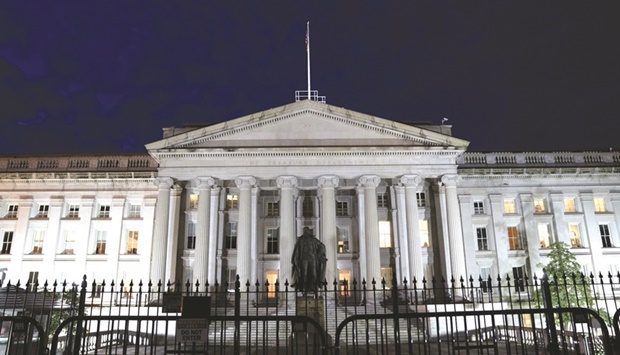Momentum towards higher yields has stalled in the world’s biggest bond market, underscoring how rapidly traders priced in the hawkish message delivered by the Federal Reserve.
The Treasury market selloff ended most dramatically in two-year notes, where yields peaked just below 2%, a level last seen in May 2019. Two-year yields have risen by nearly 50 basis points over the past two weeks and more than doubled from where they began the year – a much bigger move than has preceded previous Fed tightening cycles. More broadly, the subsequent pullback in yields reflects the view that the six additional rate increases the Fed has signalled for this year – combined with elevated inflation – will dent the economy.
Longer-dated yields rose less than the two-year’s and declined more from their peaks. In several cases they wound up lower than shorter-dated yields, a harbinger of recession. The euro-dollar futures curve, a proxy for the direction of the Fed’s policy rate, peaks in September 2023 and declines from there, an implicit expectation that the Fed will be cutting rates by then to jump start growth.
“A lot is already priced in as far as hikes for this year and early next year,” said Yvette Klevan, portfolio manager in the global fixed-income team at Lazard Asset Management, which oversees about $240bn in assets. “I’m not completely convinced that all of this will be realised,” with Russia’s war on Ukraine and the pandemic complicating the outlook.
The Fed’s aim is to bring inflation down without causing a recession. Its preferred inflation gauge in January was more than triple the central banks’ long-run target rate of 2%, and other measures of inflation such as the Consumer Price Index are higher still.
Chair Jerome Powell in his post-meeting news conference this week said the probability of a recession in the next year “is not particularly elevated,” judging by spending and labour market conditions, and that the economy “is very strong and well positioned to withstand tighter monetary policy.” Investors have doubts.
“We are less convinced on the underlying strength in both demand and labour markets, so remain sceptical that they follow through with their full hiking programme,” said Steven Englander, global head of G-10 FX research at Standard Chartered Bank. “The Fed may use the next few meetings to front-load hikes while such moves are popular politically and with the public.”
The quarterly forecasts for their policy rate that Fed officials released this week had medians of 1.875% at year-end and 2.75% at the end of 2023, corresponding to six additional quarter-point increases this year and at least two more next year. The rate, for which the central bank sets a band, was increased to 0.25%-0.50% from 0%-0.25%.
However the dispersion of forecasts was extremely wide by historical standards, ranging from 1.375%-3.125% for this year and 2.125%-3.625% for next year. St Louis Fed President James Bullard, who dissented from the decision in favour of a half-point increase, on Friday identified himself as the high forecaster for this year.
Shortly afterward, Fed Governor Christopher Waller said the war in Ukraine was the reason he didn’t push for a half-point increase at the meeting. Policy makers, who refrain from making public comments during the week or so leading up to their meetings, will be out in force again next week.
The Fed “can’t be too zealous and tighten the screws too tight for the economy,” said Kevin Flanagan, head of fixed income strategy at Wisdom Tree Investments.

The Treasury Department in Washington, DC. Momentum towards higher yields has stalled in the world’s biggest bond market, underscoring how rapidly traders priced in the hawkish message delivered by the Federal Reserve.


